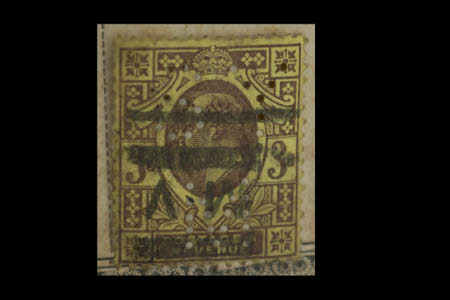Stamp
Category
Ephemera
Date
Unknown
Materials
paper, ink, glue
Measurements
23 x 20 mm
Order this imageCollection
Mr Straw's House, Nottinghamshire
NT 748711.34
Caption
Edward VII (Albert Edward; 9 November 1841 – 6 May 1910) was King of the United Kingdom of Great Britain and Ireland and Emperor of India from 22 January 1901 until his death in 1910. The eldest son of Queen Victoria and Prince Albert of Saxe-Coburg and Gotha, Edward was related to royalty throughout Europe. He was heir apparent to the British throne and held the title of Prince of Wales for longer than any of his predecessors. He was heir presumptive to the Duchy of Saxe-Coburg and Gotha until before his marriage he renounced his right to the duchy, which then devolved to his younger brother Alfred. During the long reign of his mother, he was largely excluded from political power, and came to personify the fashionable, leisured elite. He travelled throughout Britain performing ceremonial public duties, and represented Britain on visits abroad. His tours of North America in 1860 and the Indian subcontinent in 1875 were popular successes, but despite public approval his reputation as a playboy prince soured his relationship with his mother. As king, Edward played a role in the modernisation of the British Home Fleet and the reorganisation of the British Army after the Second Boer War. He reinstituted traditional ceremonies as public displays and broadened the range of people with whom royalty socialised. He fostered good relations between Britain and other European countries, especially France, for which he was popularly called "Peacemaker", but his relationship with his nephew, the German Emperor Wilhelm II, was poor. The Edwardian era, which covered Edward's reign and was named after him, coincided with the start of a new century and heralded significant changes in technology and society, including steam turbine propulsion and the rise of socialism. He died in 1910 in the midst of a constitutional crisis that was resolved the following year by the Parliament Act 1911, which restricted the power of the unelected House of Lords.
Summary
Postage stamp - olive and yellow printed stamp depicting head of King Edward VII in a circular frame, surrounded by intricate decorative patterns. To the left and right of the head are the figures '3d' There is an upside down black postal mark consisting of two horizontal lines and the letters 'M V'. The stamp is on page 6 'BRITISH EMPIRE GREAT BRITAIN AND IRELAND', fifth stamp on fifth row.The stamp is kept in 'THE WORLD POSTAGE STAMP ALBUM' with blue book boards and two world globes front centre in black and white surrounded by a series of world stamp images. On the back in the centre printed in black are two crossed flags depicting the British flag above a globe. The album contains a hundred and forty five pages, plus an additional page added at the rear of 'United South Africa' taken from another album (record 748711.1).
Provenance
Straw collection bequeathed to The National Trust on the death in 1990 of William Straw.
